-
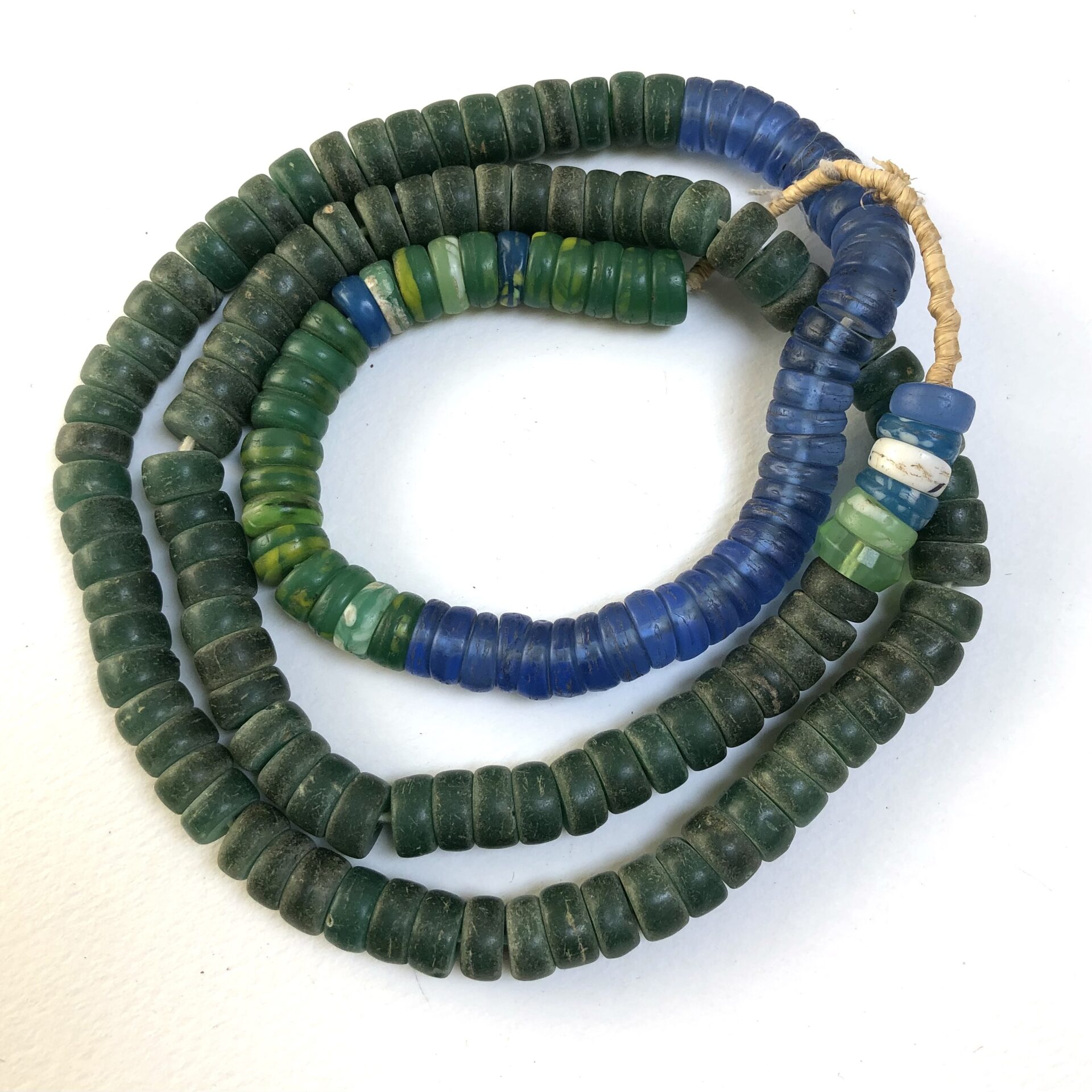
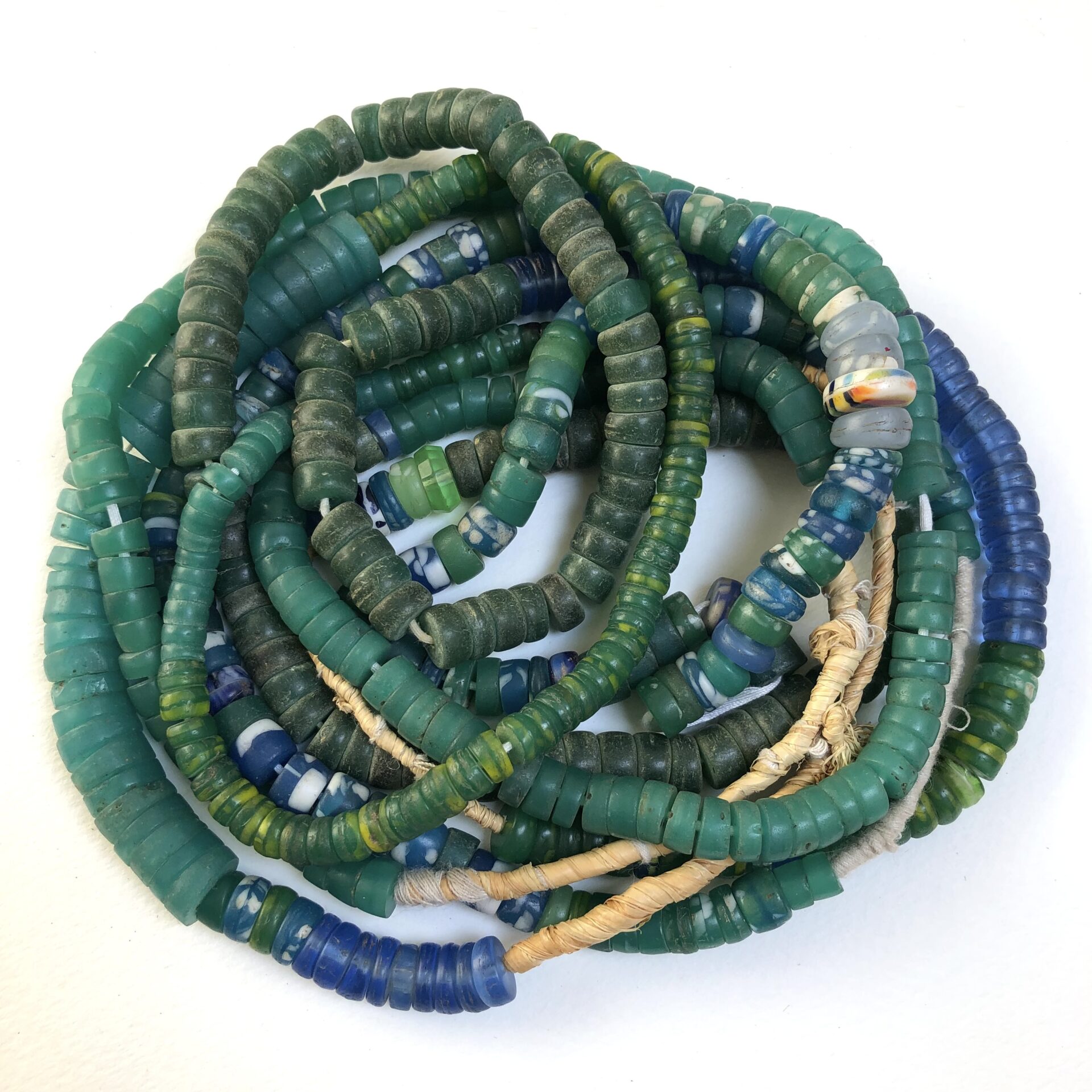 There are 4 strands of Kakamba Prosser for you to choose from. These are great spacer beads. Prosser beads are by extension any beads made by the 'Prosser' technique, invented by the Prosser brothers in 1840 in England for the purpose of making buttons. The process consists of molding a cold paste under great pressure and then firing it. Prosser Beads were distinct from other European trade beads in that they were produced in a great variety of colors, and were also translucent. They were received particularly well in the town of Kakamba in the Republic of the Congo – hence the name Kakamba Prosser Beads.
There are 4 strands of Kakamba Prosser for you to choose from. These are great spacer beads. Prosser beads are by extension any beads made by the 'Prosser' technique, invented by the Prosser brothers in 1840 in England for the purpose of making buttons. The process consists of molding a cold paste under great pressure and then firing it. Prosser Beads were distinct from other European trade beads in that they were produced in a great variety of colors, and were also translucent. They were received particularly well in the town of Kakamba in the Republic of the Congo – hence the name Kakamba Prosser Beads. -
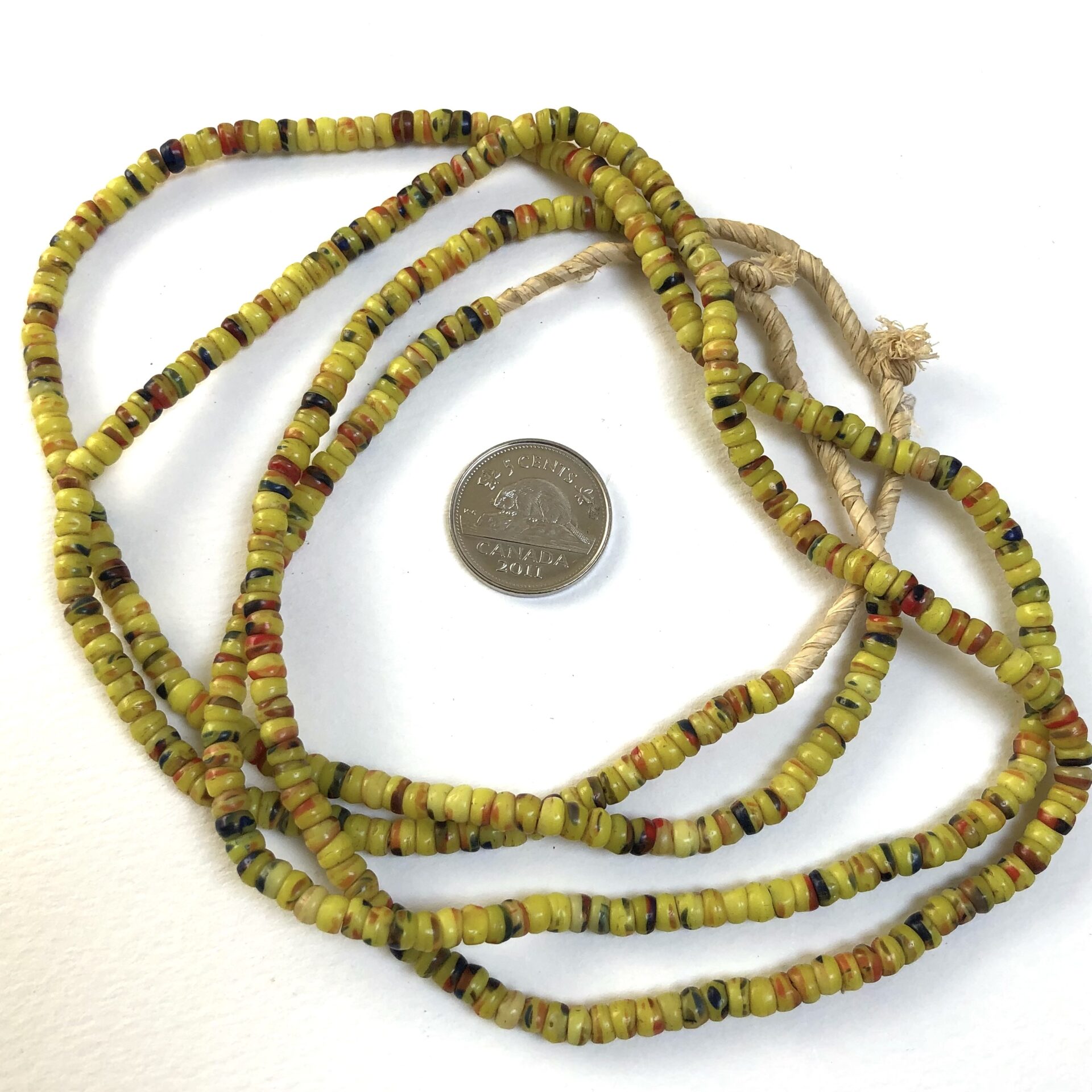
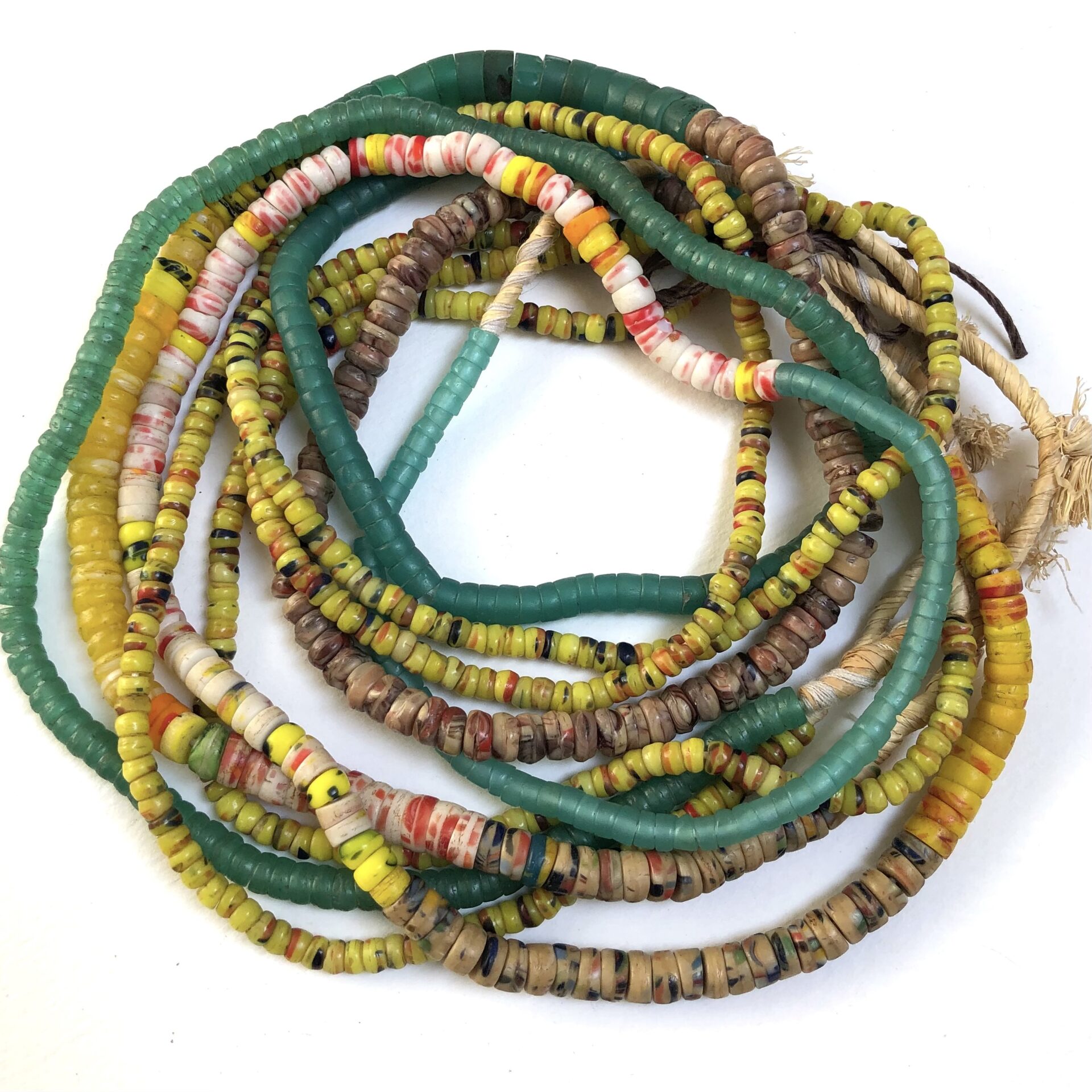 A strand of Kakamba Prosser Beads about 24" long. There are 4 strands for you to choose from. These are great spacer beads. Prosser beads are by extension any beads made by the 'Prosser' technique, invented by the Prosser brothers in 1840 in England for the purpose of making buttons. The process consists of molding a cold paste under great pressure and then firing it. Prosser Beads were distinct from other European trade beads in that they were produced in a great variety of colors, and were also translucent. They were received particularly well in the town of Kakamba in the Republic of the Congo – hence the name Kakamba Prosser Beads.
A strand of Kakamba Prosser Beads about 24" long. There are 4 strands for you to choose from. These are great spacer beads. Prosser beads are by extension any beads made by the 'Prosser' technique, invented by the Prosser brothers in 1840 in England for the purpose of making buttons. The process consists of molding a cold paste under great pressure and then firing it. Prosser Beads were distinct from other European trade beads in that they were produced in a great variety of colors, and were also translucent. They were received particularly well in the town of Kakamba in the Republic of the Congo – hence the name Kakamba Prosser Beads. -
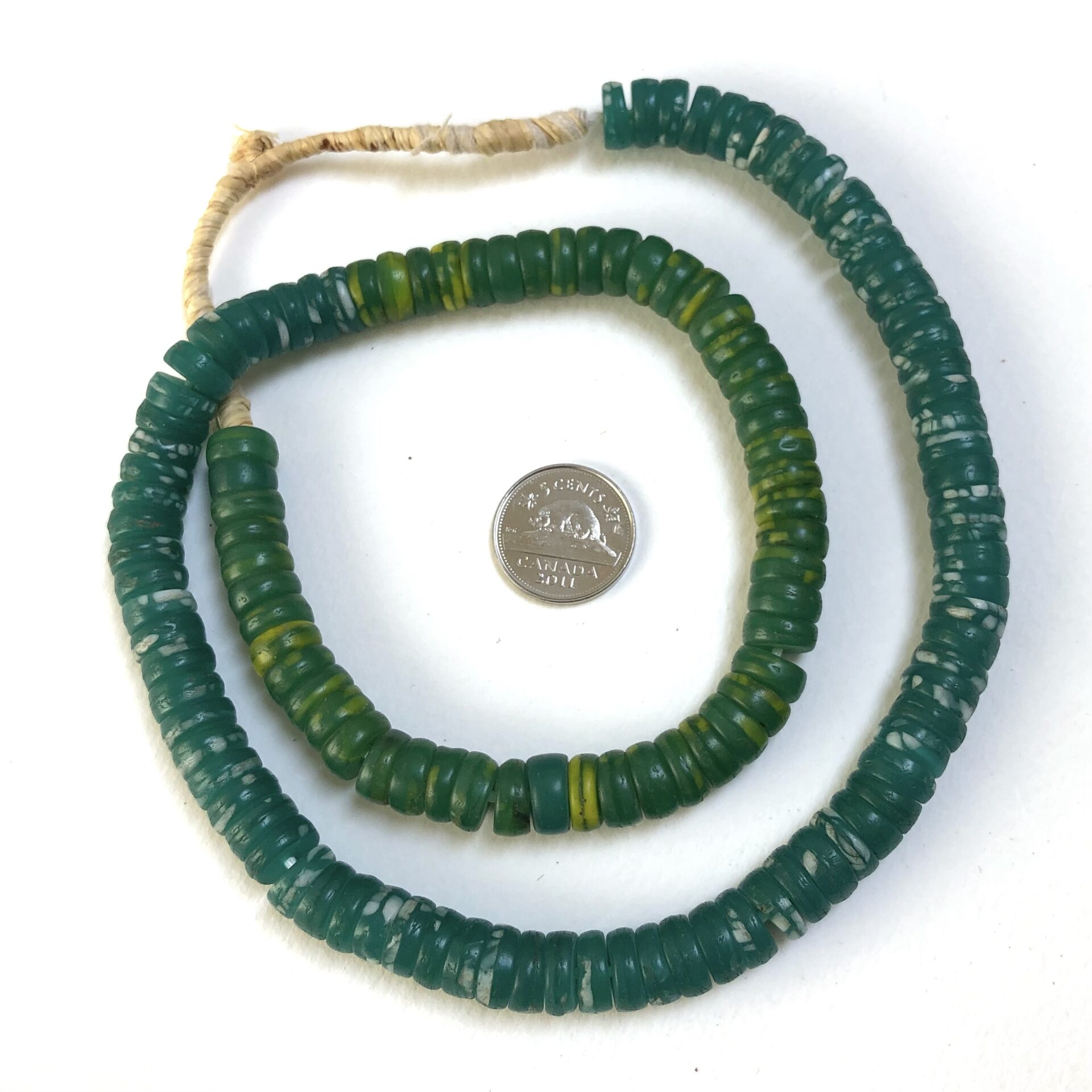
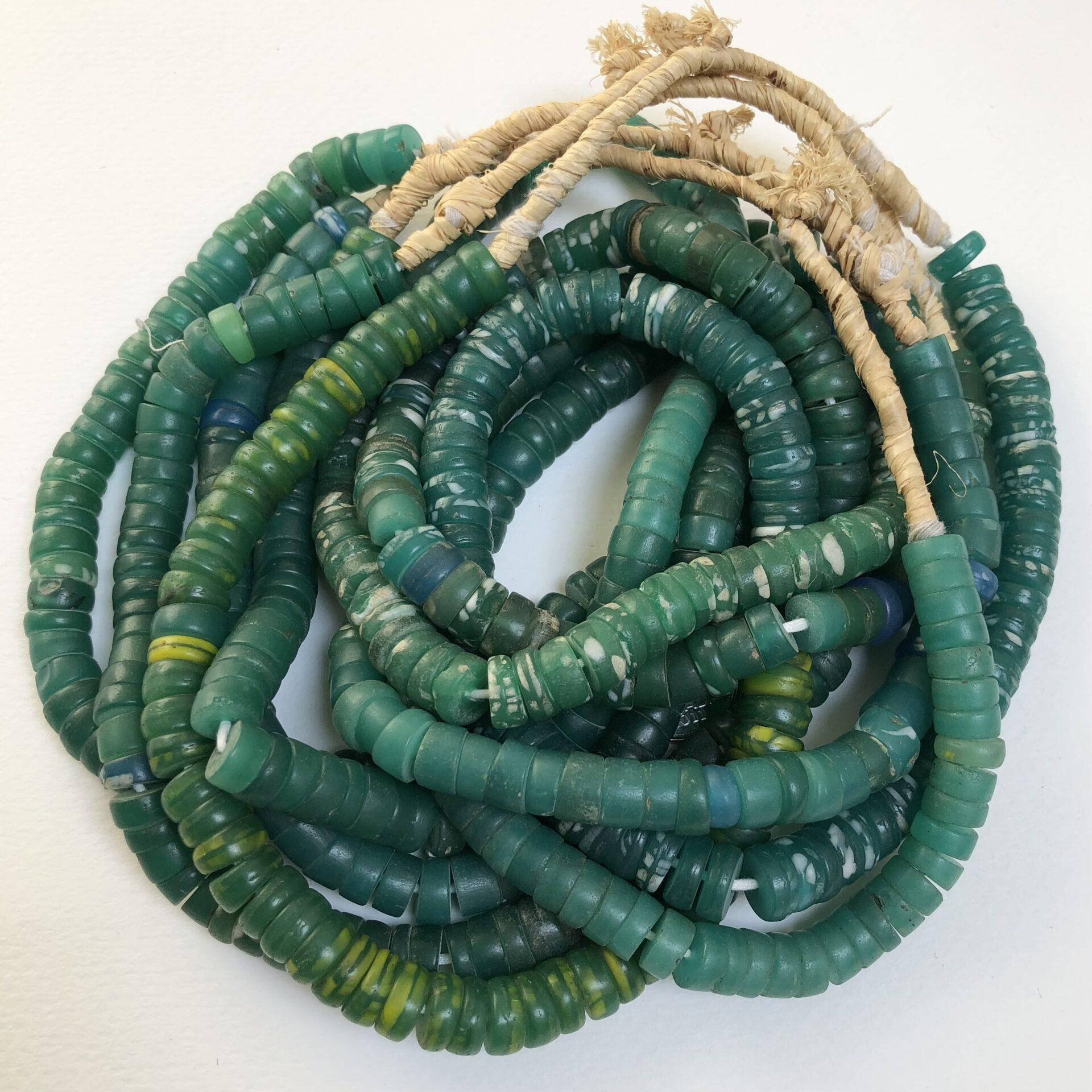 A strand of Kakamba Prosser Beads about 24" long. There are 5 strands for you to choose from. These are great spacer beads. Prosser beads are by extension any beads made by the 'Prosser' technique, invented by the Prosser brothers in 1840 in England for the purpose of making buttons. The process consists of molding a cold paste under great pressure and then firing it. Prosser Beads were distinct from other European trade beads in that they were produced in a great variety of colors, and were also translucent. They were received particularly well in the town of Kakamba in the Republic of the Congo – hence the name Kakamba Prosser Beads.
A strand of Kakamba Prosser Beads about 24" long. There are 5 strands for you to choose from. These are great spacer beads. Prosser beads are by extension any beads made by the 'Prosser' technique, invented by the Prosser brothers in 1840 in England for the purpose of making buttons. The process consists of molding a cold paste under great pressure and then firing it. Prosser Beads were distinct from other European trade beads in that they were produced in a great variety of colors, and were also translucent. They were received particularly well in the town of Kakamba in the Republic of the Congo – hence the name Kakamba Prosser Beads. -
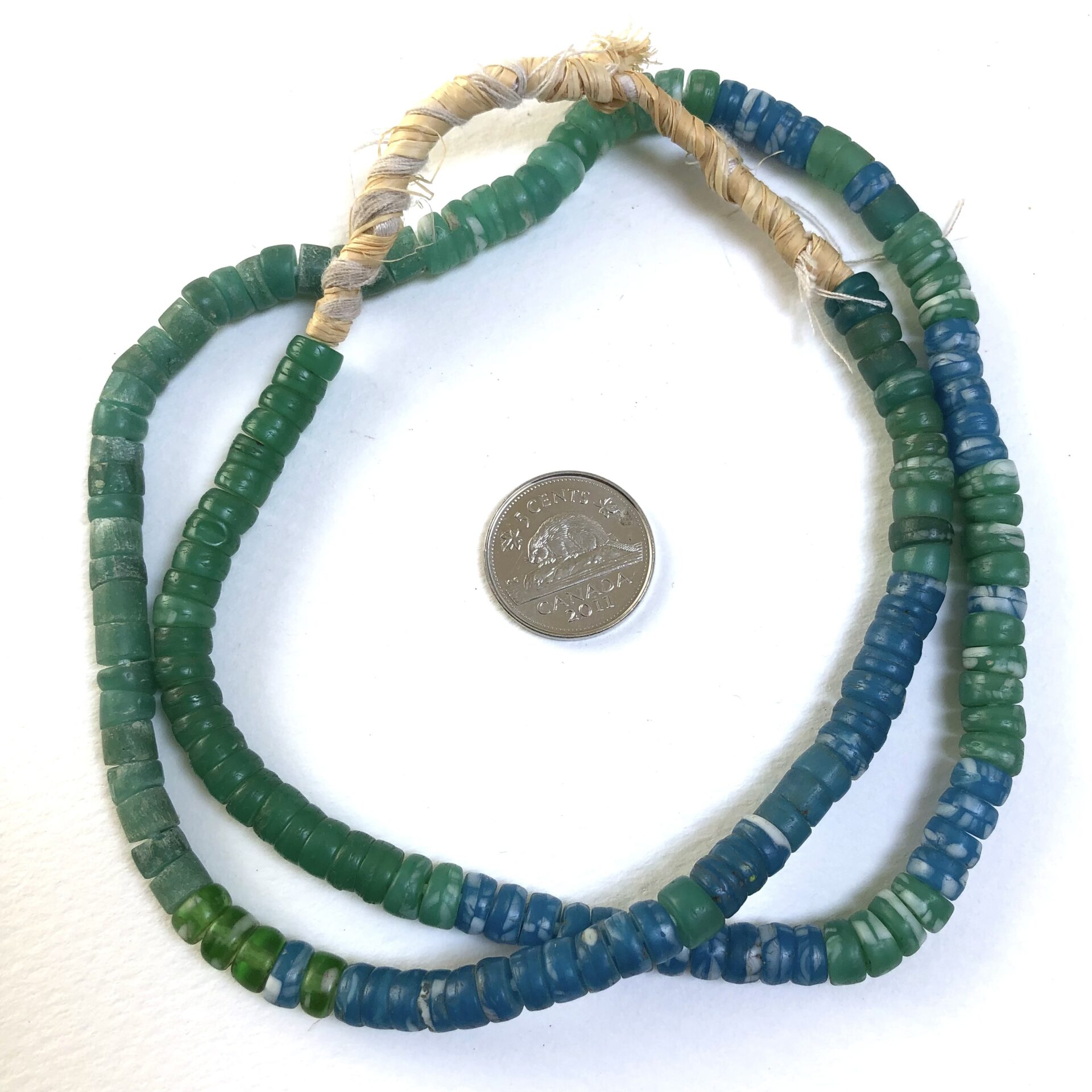
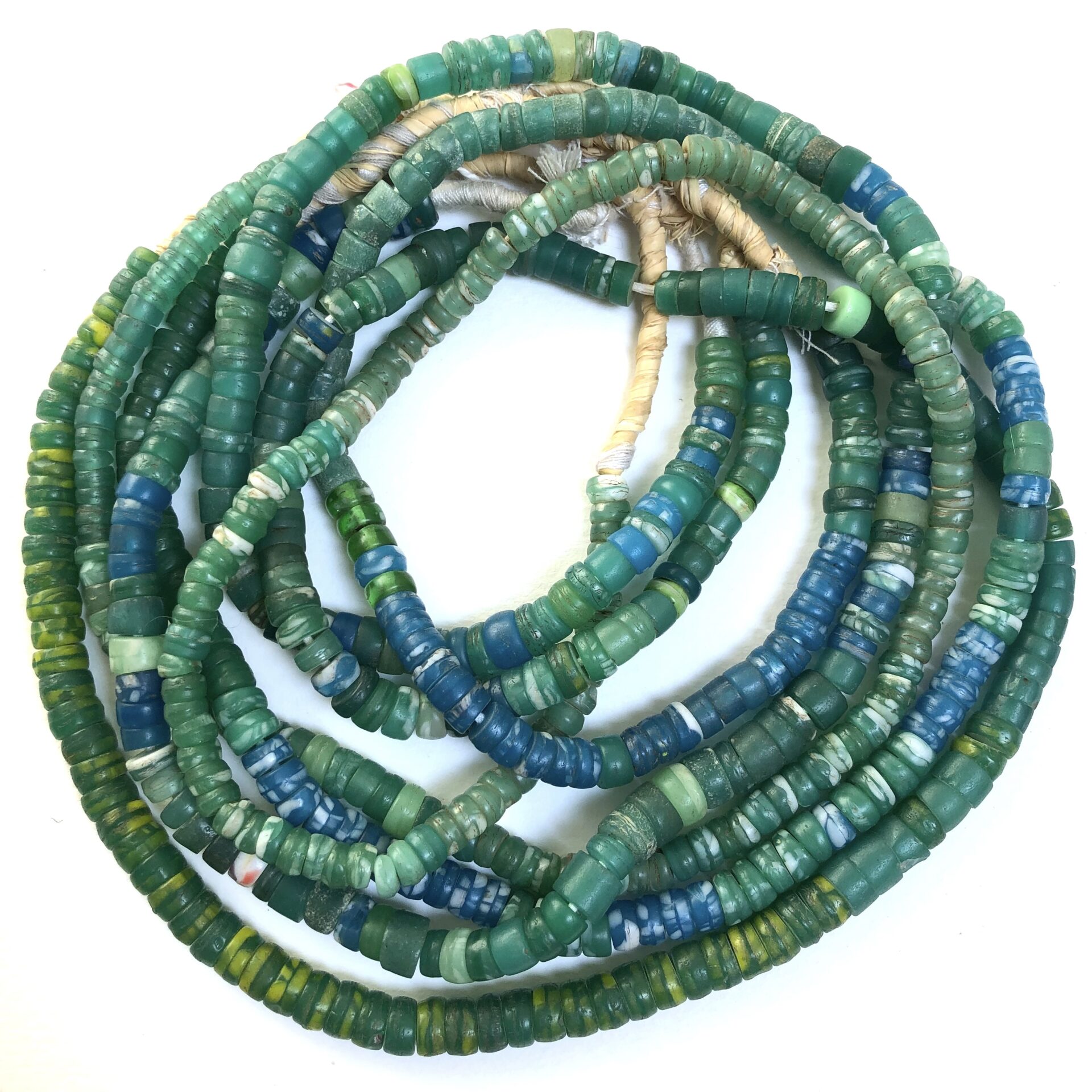 A strand of Kakamba Prosser Beads about 24" long. There are 4 strands for you to choose from. These are great spacer beads. Prosser beads are by extension any beads made by the 'Prosser' technique, invented by the Prosser brothers in 1840 in England for the purpose of making buttons. The process consists of molding a cold paste under great pressure and then firing it. Prosser Beads were distinct from other European trade beads in that they were produced in a great variety of colors, and were also translucent. They were received particularly well in the town of Kakamba in the Republic of the Congo – hence the name Kakamba Prosser Beads.
A strand of Kakamba Prosser Beads about 24" long. There are 4 strands for you to choose from. These are great spacer beads. Prosser beads are by extension any beads made by the 'Prosser' technique, invented by the Prosser brothers in 1840 in England for the purpose of making buttons. The process consists of molding a cold paste under great pressure and then firing it. Prosser Beads were distinct from other European trade beads in that they were produced in a great variety of colors, and were also translucent. They were received particularly well in the town of Kakamba in the Republic of the Congo – hence the name Kakamba Prosser Beads. -

 A strand of Kakamba Prosser Beads about 24" long. The glass beads are about 3-4 mm in diameter. These are great spacer beads.3/4 of the beads are a translucent yellot and the rest are an opaque yellow, black and red mix. Prosser beads are by extension any beads made by the 'Prosser' technique, invented by the Prosser brothers in 1840 in England for the purpose of making buttons. The process consists of molding a cold paste under great pressure and then firing it. Prosser Beads were distinct from other European trade beads in that they were produced in a great variety of colors, and were also translucent. They were received particularly well in the town of Kakamba in the Republic of the Congo – hence the name Kakamba Prosser Beads.
A strand of Kakamba Prosser Beads about 24" long. The glass beads are about 3-4 mm in diameter. These are great spacer beads.3/4 of the beads are a translucent yellot and the rest are an opaque yellow, black and red mix. Prosser beads are by extension any beads made by the 'Prosser' technique, invented by the Prosser brothers in 1840 in England for the purpose of making buttons. The process consists of molding a cold paste under great pressure and then firing it. Prosser Beads were distinct from other European trade beads in that they were produced in a great variety of colors, and were also translucent. They were received particularly well in the town of Kakamba in the Republic of the Congo – hence the name Kakamba Prosser Beads. -

 A strand of Kakamba Prosser Beads about 23" long. The glass beads are about 5 mm in diameter. These are great spacer beads. An assortment of colours. You will receive a strand similar to the strands shown. There are variations between strands. Prosser beads are by extension any beads made by the 'Prosser' technique, invented by the Prosser brothers in 1840 in England for the purpose of making buttons. The process consists of molding a cold paste under great pressure and then firing it. Prosser Beads were distinct from other European trade beads in that they were produced in a great variety of colors, and were also translucent. They were received particularly well in the town of Kakamba in the Republic of the Congo – hence the name Kakamba Prosser Beads.
A strand of Kakamba Prosser Beads about 23" long. The glass beads are about 5 mm in diameter. These are great spacer beads. An assortment of colours. You will receive a strand similar to the strands shown. There are variations between strands. Prosser beads are by extension any beads made by the 'Prosser' technique, invented by the Prosser brothers in 1840 in England for the purpose of making buttons. The process consists of molding a cold paste under great pressure and then firing it. Prosser Beads were distinct from other European trade beads in that they were produced in a great variety of colors, and were also translucent. They were received particularly well in the town of Kakamba in the Republic of the Congo – hence the name Kakamba Prosser Beads. -

 A strand of over 150 Kakamba Prosser Beads about 32" long. There are two different strands to choose from. These are great spacer beads. The bead is a shade of translucent green. Prosser beads are by extension any beads made by the 'Prosser' technique, invented by the Prosser brothers in 1840 in England for the purpose of making buttons. The process consists of molding a cold paste under great pressure and then firing it. Prosser Beads were distinct from other European trade beads in that they were produced in a great variety of colors, and were also translucent. They were received particularly well in the town of Kakamba in the Republic of the Congo – hence the name Kakamba Prosser Beads.
A strand of over 150 Kakamba Prosser Beads about 32" long. There are two different strands to choose from. These are great spacer beads. The bead is a shade of translucent green. Prosser beads are by extension any beads made by the 'Prosser' technique, invented by the Prosser brothers in 1840 in England for the purpose of making buttons. The process consists of molding a cold paste under great pressure and then firing it. Prosser Beads were distinct from other European trade beads in that they were produced in a great variety of colors, and were also translucent. They were received particularly well in the town of Kakamba in the Republic of the Congo – hence the name Kakamba Prosser Beads. -

 A strand of over 125 Kakamba Prosser Beads about 31" long. The beads are about 12 mm in diameter. These are great spacer beads.The beads are a translucent light green. You will get one or other of the strands shown. Prosser beads are by extension any beads made by the 'Prosser' technique, invented by the Prosser brothers in 1840 in England for the purpose of making buttons. The process consists of molding a cold paste under great pressure and then firing it. Prosser Beads were distinct from other European trade beads in that they were produced in a great variety of colors, and were also translucent. They were received particularly well in the town of Kakamba in the Republic of the Congo – hence the name Kakamba Prosser Beads.
A strand of over 125 Kakamba Prosser Beads about 31" long. The beads are about 12 mm in diameter. These are great spacer beads.The beads are a translucent light green. You will get one or other of the strands shown. Prosser beads are by extension any beads made by the 'Prosser' technique, invented by the Prosser brothers in 1840 in England for the purpose of making buttons. The process consists of molding a cold paste under great pressure and then firing it. Prosser Beads were distinct from other European trade beads in that they were produced in a great variety of colors, and were also translucent. They were received particularly well in the town of Kakamba in the Republic of the Congo – hence the name Kakamba Prosser Beads. -

 A strand of Kakamba Prosser Beads about 30" long. The beads are about 7-8 mm in diameter. These are great spacer beads.The beads are a translucent various shade of green. You will get the strand shown. Prosser beads are by extension any beads made by the 'Prosser' technique, invented by the Prosser brothers in 1840 in England for the purpose of making buttons. The process consists of molding a cold paste under great pressure and then firing it. Prosser Beads were distinct from other European trade beads in that they were produced in a great variety of colors, and were also translucent. They were received particularly well in the town of Kakamba in the Republic of the Congo – hence the name Kakamba Prosser Beads.
A strand of Kakamba Prosser Beads about 30" long. The beads are about 7-8 mm in diameter. These are great spacer beads.The beads are a translucent various shade of green. You will get the strand shown. Prosser beads are by extension any beads made by the 'Prosser' technique, invented by the Prosser brothers in 1840 in England for the purpose of making buttons. The process consists of molding a cold paste under great pressure and then firing it. Prosser Beads were distinct from other European trade beads in that they were produced in a great variety of colors, and were also translucent. They were received particularly well in the town of Kakamba in the Republic of the Congo – hence the name Kakamba Prosser Beads. -
 A strand of Kakamba Prosser Beads about 32" long. The beads are about 8 mm in diameter. These are great spacer beads.The beads are a gorgeous translucent light green. There are two strands very similar to choose from. Prosser beads are by extension any beads made by the 'Prosser' technique, invented by the Prosser brothers in 1840 in England for the purpose of making buttons. The process consists of molding a cold paste under great pressure and then firing it. Prosser Beads were distinct from other European trade beads in that they were produced in a great variety of colors, and were also translucent. They were received particularly well in the town of Kakamba in the Republic of the Congo – hence the name Kakamba Prosser Beads.
A strand of Kakamba Prosser Beads about 32" long. The beads are about 8 mm in diameter. These are great spacer beads.The beads are a gorgeous translucent light green. There are two strands very similar to choose from. Prosser beads are by extension any beads made by the 'Prosser' technique, invented by the Prosser brothers in 1840 in England for the purpose of making buttons. The process consists of molding a cold paste under great pressure and then firing it. Prosser Beads were distinct from other European trade beads in that they were produced in a great variety of colors, and were also translucent. They were received particularly well in the town of Kakamba in the Republic of the Congo – hence the name Kakamba Prosser Beads. -
Out of stock

 A strand of about 74 Kakamba Prosser Beads on string 30" long. Each bead is about 11 mm in diameter. These are great spacer beads. Prosser beads are by extension any beads made by the 'Prosser' technique, invented by the Prosser brothers in 1840 in England for the purpose of making buttons. The process consists of molding a cold paste under great pressure and then firing it. Prosser Beads were distinct from other European trade beads in that they were produced in a great variety of colors, and were also translucent. They were received particularly well in the town of Kakamba in the Republic of the Congo – hence the name Kakamba Prosser Beads.
A strand of about 74 Kakamba Prosser Beads on string 30" long. Each bead is about 11 mm in diameter. These are great spacer beads. Prosser beads are by extension any beads made by the 'Prosser' technique, invented by the Prosser brothers in 1840 in England for the purpose of making buttons. The process consists of molding a cold paste under great pressure and then firing it. Prosser Beads were distinct from other European trade beads in that they were produced in a great variety of colors, and were also translucent. They were received particularly well in the town of Kakamba in the Republic of the Congo – hence the name Kakamba Prosser Beads. -

 A strand of Kakamba Prosser Beads about 30" long. The glass beads are about 6-9 mm in diameter. These are great spacer beads. You will receive the strand displayed. Prosser beads are by extension any beads made by the 'Prosser' technique, invented by the Prosser brothers in 1840 in England for the purpose of making buttons. The process consists of molding a cold paste under great pressure and then firing it. Prosser Beads were distinct from other European trade beads in that they were produced in a great variety of colors, and were also translucent. They were received particularly well in the town of Kakamba in the Republic of the Congo – hence the name Kakamba Prosser Beads.
A strand of Kakamba Prosser Beads about 30" long. The glass beads are about 6-9 mm in diameter. These are great spacer beads. You will receive the strand displayed. Prosser beads are by extension any beads made by the 'Prosser' technique, invented by the Prosser brothers in 1840 in England for the purpose of making buttons. The process consists of molding a cold paste under great pressure and then firing it. Prosser Beads were distinct from other European trade beads in that they were produced in a great variety of colors, and were also translucent. They were received particularly well in the town of Kakamba in the Republic of the Congo – hence the name Kakamba Prosser Beads. -

 A strand of Kakamba Prosser Beads about 30" long. The glass beads are about 7 mm in diameter. These are great spacer beads. You will receive one of the strands displayed. Prosser beads are by extension any beads made by the 'Prosser' technique, invented by the Prosser brothers in 1840 in England for the purpose of making buttons. The process consists of molding a cold paste under great pressure and then firing it. Prosser Beads were distinct from other European trade beads in that they were produced in a great variety of colors, and were also translucent. They were received particularly well in the town of Kakamba in the Republic of the Congo – hence the name Kakamba Prosser Beads.
A strand of Kakamba Prosser Beads about 30" long. The glass beads are about 7 mm in diameter. These are great spacer beads. You will receive one of the strands displayed. Prosser beads are by extension any beads made by the 'Prosser' technique, invented by the Prosser brothers in 1840 in England for the purpose of making buttons. The process consists of molding a cold paste under great pressure and then firing it. Prosser Beads were distinct from other European trade beads in that they were produced in a great variety of colors, and were also translucent. They were received particularly well in the town of Kakamba in the Republic of the Congo – hence the name Kakamba Prosser Beads. -

 A strand of Kakamba Prosser Beads about 32" long. The glass beads are about 9 mm in diameter. These are great spacer beads. You will receive the strand displayed with the penny. Prosser beads are by extension any beads made by the 'Prosser' technique, invented by the Prosser brothers in 1840 in England for the purpose of making buttons. The process consists of molding a cold paste under great pressure and then firing it. Prosser Beads were distinct from other European trade beads in that they were produced in a great variety of colors, and were also translucent. They were received particularly well in the town of Kakamba in the Republic of the Congo – hence the name Kakamba Prosser Beads.
A strand of Kakamba Prosser Beads about 32" long. The glass beads are about 9 mm in diameter. These are great spacer beads. You will receive the strand displayed with the penny. Prosser beads are by extension any beads made by the 'Prosser' technique, invented by the Prosser brothers in 1840 in England for the purpose of making buttons. The process consists of molding a cold paste under great pressure and then firing it. Prosser Beads were distinct from other European trade beads in that they were produced in a great variety of colors, and were also translucent. They were received particularly well in the town of Kakamba in the Republic of the Congo – hence the name Kakamba Prosser Beads. -
Out of stock

 A strand of blue Kakamba Prosser Beads about 34" long. The glass beads are about 8 mm in diameter. These are great spacer beads. Prosser beads are by extension any beads made by the 'Prosser' technique, invented by the Prosser brothers in 1840 in England for the purpose of making buttons. The process consists of molding a cold paste under great pressure and then firing it. Prosser Beads were distinct from other European trade beads in that they were produced in a great variety of colors, and were also translucent. They were received particularly well in the town of Kakamba in the Republic of the Congo – hence the name Kakamba Prosser Beads.
A strand of blue Kakamba Prosser Beads about 34" long. The glass beads are about 8 mm in diameter. These are great spacer beads. Prosser beads are by extension any beads made by the 'Prosser' technique, invented by the Prosser brothers in 1840 in England for the purpose of making buttons. The process consists of molding a cold paste under great pressure and then firing it. Prosser Beads were distinct from other European trade beads in that they were produced in a great variety of colors, and were also translucent. They were received particularly well in the town of Kakamba in the Republic of the Congo – hence the name Kakamba Prosser Beads. -

 A strand of Kakamba Prosser Beads about 22" long. The glass beads are about 6-12 mm in diameter. These are great spacer beads. You will receive the strand displayed. Prosser beads are by extension any beads made by the 'Prosser' technique, invented by the Prosser brothers in 1840 in England for the purpose of making buttons. The process consists of molding a cold paste under great pressure and then firing it. Prosser Beads were distinct from other European trade beads in that they were produced in a great variety of colors, and were also translucent. They were received particularly well in the town of Kakamba in the Republic of the Congo – hence the name Kakamba Prosser Beads.
A strand of Kakamba Prosser Beads about 22" long. The glass beads are about 6-12 mm in diameter. These are great spacer beads. You will receive the strand displayed. Prosser beads are by extension any beads made by the 'Prosser' technique, invented by the Prosser brothers in 1840 in England for the purpose of making buttons. The process consists of molding a cold paste under great pressure and then firing it. Prosser Beads were distinct from other European trade beads in that they were produced in a great variety of colors, and were also translucent. They were received particularly well in the town of Kakamba in the Republic of the Congo – hence the name Kakamba Prosser Beads. -

 A strand of Kakamba Prosser Beads about 32" long. There are two of these stands that are very similar. However you can choose between the strand where the beads are all about 12 mm or the strand where the beads vary between 9 to 12 mm in diameter. These are great spacer beads.The majority are a translucent green with some that are speckled with white. Prosser beads are by extension any beads made by the 'Prosser' technique, invented by the Prosser brothers in 1840 in England for the purpose of making buttons. The process consists of molding a cold paste under great pressure and then firing it. Prosser Beads were distinct from other European trade beads in that they were produced in a great variety of colors, and were also translucent. They were received particularly well in the town of Kakamba in the Republic of the Congo – hence the name Kakamba Prosser Beads.
A strand of Kakamba Prosser Beads about 32" long. There are two of these stands that are very similar. However you can choose between the strand where the beads are all about 12 mm or the strand where the beads vary between 9 to 12 mm in diameter. These are great spacer beads.The majority are a translucent green with some that are speckled with white. Prosser beads are by extension any beads made by the 'Prosser' technique, invented by the Prosser brothers in 1840 in England for the purpose of making buttons. The process consists of molding a cold paste under great pressure and then firing it. Prosser Beads were distinct from other European trade beads in that they were produced in a great variety of colors, and were also translucent. They were received particularly well in the town of Kakamba in the Republic of the Congo – hence the name Kakamba Prosser Beads. -

 A strand of Kakamba Prosser Beads about 23" long. The glass beads are about 6-9 mm in diameter. These are great spacer beads. An assortment of colours and sizes. You will receive the strand shown. Prosser beads are by extension any beads made by the 'Prosser' technique, invented by the Prosser brothers in 1840 in England for the purpose of making buttons. The process consists of molding a cold paste under great pressure and then firing it. Prosser Beads were distinct from other European trade beads in that they were produced in a great variety of colors, and were also translucent. They were received particularly well in the town of Kakamba in the Republic of the Congo – hence the name Kakamba Prosser Beads.
A strand of Kakamba Prosser Beads about 23" long. The glass beads are about 6-9 mm in diameter. These are great spacer beads. An assortment of colours and sizes. You will receive the strand shown. Prosser beads are by extension any beads made by the 'Prosser' technique, invented by the Prosser brothers in 1840 in England for the purpose of making buttons. The process consists of molding a cold paste under great pressure and then firing it. Prosser Beads were distinct from other European trade beads in that they were produced in a great variety of colors, and were also translucent. They were received particularly well in the town of Kakamba in the Republic of the Congo – hence the name Kakamba Prosser Beads. -

 A gorgeous barrel shaped bead 21 x 28 mm with a carved design that is brushed with a brick colour... Would make a beautiful pendant! Please note that these beads were handmade so each bead varies. You will receive one that is similar to the ones in the photo. If you get six beads the sixth one is free ! (so in actual fact only order five and i will put in the free one :) My affection for these beads grew when I heard that these 'Spindles' actually evolved into the beads they are today because of our avid collectioner's heart (all Beaders have one of those!) Originally these Spindles were actually made to spin cotton but then people started collecting them because they were so beautiful. They became rare .. so some enterprising people started making new ones but more as the beads they are today... They are so beautiful and evoke the country, Africa just by handling them and by the fact they are made of Africa's earth.
A gorgeous barrel shaped bead 21 x 28 mm with a carved design that is brushed with a brick colour... Would make a beautiful pendant! Please note that these beads were handmade so each bead varies. You will receive one that is similar to the ones in the photo. If you get six beads the sixth one is free ! (so in actual fact only order five and i will put in the free one :) My affection for these beads grew when I heard that these 'Spindles' actually evolved into the beads they are today because of our avid collectioner's heart (all Beaders have one of those!) Originally these Spindles were actually made to spin cotton but then people started collecting them because they were so beautiful. They became rare .. so some enterprising people started making new ones but more as the beads they are today... They are so beautiful and evoke the country, Africa just by handling them and by the fact they are made of Africa's earth. -

 A strand of Recycled Glass Waist beads strung on string 16" long. These are the smallest recycled glass beads and great spacer beads. These beads are a salmon red. There is an image which shows the different reds. And also an image that shows the two salmon reds. The salmon red is the lighter of the two. The waist beads are hand made and therefore there will be variations in size and colour. Funky Frog loves to use these beads in tassels!
A strand of Recycled Glass Waist beads strung on string 16" long. These are the smallest recycled glass beads and great spacer beads. These beads are a salmon red. There is an image which shows the different reds. And also an image that shows the two salmon reds. The salmon red is the lighter of the two. The waist beads are hand made and therefore there will be variations in size and colour. Funky Frog loves to use these beads in tassels! -

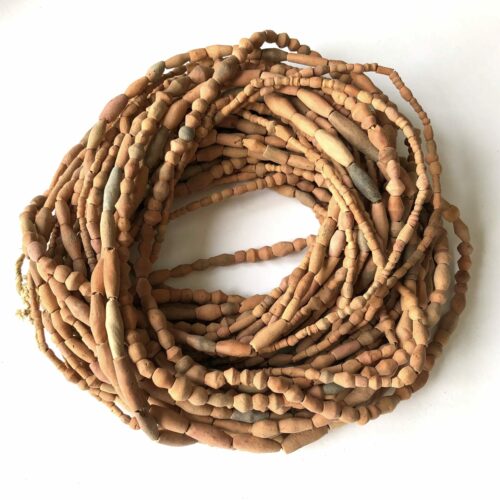 Two strands of tiny delicate clay beads from Mali strung on rafia about 34" long. The beads are a uniform terracotta colour. These were bought directly from a Bead Trader in Ghana, W. Africa. There are two slight variations in the strands: 2nd image is Mini-1 and 3rd image is Mini-2. You will receive one of those pairs. If you have a preference please contact us.
Two strands of tiny delicate clay beads from Mali strung on rafia about 34" long. The beads are a uniform terracotta colour. These were bought directly from a Bead Trader in Ghana, W. Africa. There are two slight variations in the strands: 2nd image is Mini-1 and 3rd image is Mini-2. You will receive one of those pairs. If you have a preference please contact us. -

 A beautiful strand of 6 dark grey with white designs Clay Spindle beads from Mali strung on raffia. These beads have a smooth polished feel with dramatic geometric designs. The beads are 30 mm in diameter. The beads are handmade and will vary in shape, patterns and colour. The string you receive will be similar to the one in the photo. My affection for these beads dates back to when I first heard that these 'Spindles' actually evolved into the beads they are today because of our avid collectioner's heart (all Beaders have one of those!) Originally these Spindles were actually made to spin cotton but then people started collecting them because they were so beautiful. They became rare .. so some enterprising people started making new ones but more as the beads they are today... They are so beautiful and evoke the country, Africa just by handling them and by the fact that they are made from Africa's earth.
A beautiful strand of 6 dark grey with white designs Clay Spindle beads from Mali strung on raffia. These beads have a smooth polished feel with dramatic geometric designs. The beads are 30 mm in diameter. The beads are handmade and will vary in shape, patterns and colour. The string you receive will be similar to the one in the photo. My affection for these beads dates back to when I first heard that these 'Spindles' actually evolved into the beads they are today because of our avid collectioner's heart (all Beaders have one of those!) Originally these Spindles were actually made to spin cotton but then people started collecting them because they were so beautiful. They became rare .. so some enterprising people started making new ones but more as the beads they are today... They are so beautiful and evoke the country, Africa just by handling them and by the fact that they are made from Africa's earth. -

 A strand of 6 grey with white Sun designs Clay Spindle beads from Mali. The beads are 28 mm in diameter. You will receive 6 beads as shown in the photo. Please note that these beads were handmade so each bead varies. In the second photo the big brother is shown :) ... My affection for these beads grew when I heard that these 'Spindles' actually evolved into the beads they are today because of our avid collectioner's heart (all Beaders have one of those!) Originally these Spindles were actually made to spin cotton but then people started collecting them because they were so beautiful. They became rare .. so some enterprising people started making new ones but more as the beads they are today... They are so beautiful and evoke the country, Africa just by handling them and by the fact they are made of Africa's earth.
A strand of 6 grey with white Sun designs Clay Spindle beads from Mali. The beads are 28 mm in diameter. You will receive 6 beads as shown in the photo. Please note that these beads were handmade so each bead varies. In the second photo the big brother is shown :) ... My affection for these beads grew when I heard that these 'Spindles' actually evolved into the beads they are today because of our avid collectioner's heart (all Beaders have one of those!) Originally these Spindles were actually made to spin cotton but then people started collecting them because they were so beautiful. They became rare .. so some enterprising people started making new ones but more as the beads they are today... They are so beautiful and evoke the country, Africa just by handling them and by the fact they are made of Africa's earth.


